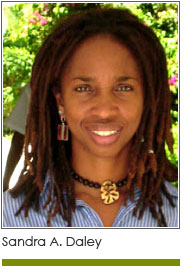 Little is more extraordinary than the decision to commit ourselves to a quality education for our children; especially those of us who choose to place our children in primarily white private schools. More and more, it is confirmed that education provides access and access is power. In order for our children to compete equitably in the global marketplace, we need to ensure a quality education and access to resources taken for granted by those white and privileged.
Little is more extraordinary than the decision to commit ourselves to a quality education for our children; especially those of us who choose to place our children in primarily white private schools. More and more, it is confirmed that education provides access and access is power. In order for our children to compete equitably in the global marketplace, we need to ensure a quality education and access to resources taken for granted by those white and privileged.
Every day, media reminds and forces us to acknowledge how poverty and lack of access might compel us, families of color, to step out of our comfort zones to those environments more strange and challenging. Decades ago, entry into these private institutions was an enormous risk. It was oftentimes a dangerous, emotional and physical risk endured alone. We have seen progress but overpoweringly evident the inequity that exists between the quality of education available to the white and privileged, and to those of color and of lesser means.
Admission into these private schools introduces the child of color to a succession of codes and will gild the pathway of each child that survives it. This is the beginning of a life hopefully filled with opportunities and options. For many of our children, it is the first time they or their families grace these ivied walls. Now they will learn to socialize with people essentially different from themselves. Now they would collide with race issues, learn to understand ways of privilege and entitlement, and manage to survive in a community that seeks to call itself diverse.
Initially and continually, our families grapple with the daring costs of a private education. Our children say good-bye to their neighborhood friends, whom they would expect to see at evening hours and overlapping holidays. They start their journeys from ethnic outer boros to swanky suburbia. Some take public transportation, while others are bussed door-to-door. Many hours are spent away from home, while their parents work a full time job or two to pay rising tuition costs and expenses. We become crafty at completing financial aid forms and experts at advocating for desired enrichment programs for our daughter. After school programs and camps become essential for those of us who work outside the home and creating alliances with other families become essential to survival.
Our children quickly learn to live a dual life, a life that many of us know nothing about having never attended a private school ourselves. Solely, the child navigates school life even with best intentions. As our children get older and seek more earnestly to define themselves, conflicts around race and culture dominate their school experience. Retention, how well our children survive in these institutions, depends on how well we as parents, school administrators, and the community at large assist in creating an inclusive school environment. Many of our families leave these institutions, challenged by finances and unending cultural stresses.
For most of our families, we know the challenges are part and parcel, when you embark on that road to access and opportunity. Transplanted from our homogenous communities, we are reminded daily that we are “visitors.” Our children prepare for long days that may start in the Early Bird Room, before classes and end in a variety of after school activities. But we teach our children never to complain. After all, we also work long hours without the help of a Caribbean nanny. This means that everyone does his or her part in the pursuit of a quality education.
Our people, for many decades, have sacrificed much in the pursuit of education. Still today, our child may be the only child of color in a classroom. If lucky, they will be clustered with an Asian or Indian child. Not so likely, a Puerto Rican or Latino child.
Each day our children must balance the act of assimilation and the urge to follow the drum beat of their personal culture. Our children ask, how much of myself can I bring into a predominately white classroom? How do I sit in the midst of enormous wealth and squelch feelings of envy? Remain full of self-worth? Remain prideful?
More and more as communities transition from micro to global private schools recognize that a world-class education is at best, a diverse one. Globalization increases the demand for diversity and multi-culturalism. Schools quickly realize the need to launch initiatives to attract families not usual to their communities. They must not only attract families of color but they must retain them. They recognize that our families can contribute to the strength, openness, and growth of their communities.
With this noble dream, keep in mind, as we add to the kaleidoscope of their institutions, education goes both ways. As much as we are there to learn, we are also contributors with a rich resource of culture, perspective, language, and a new way of thinking.
Sandra Daley is an artist who resides in the village of Harlem, New York City.

















